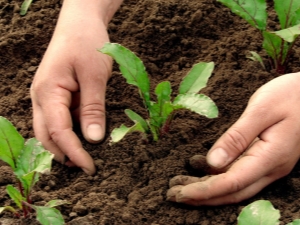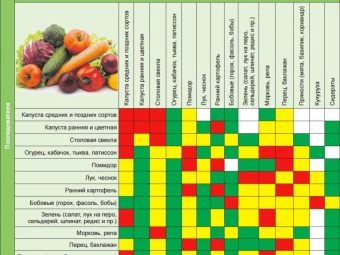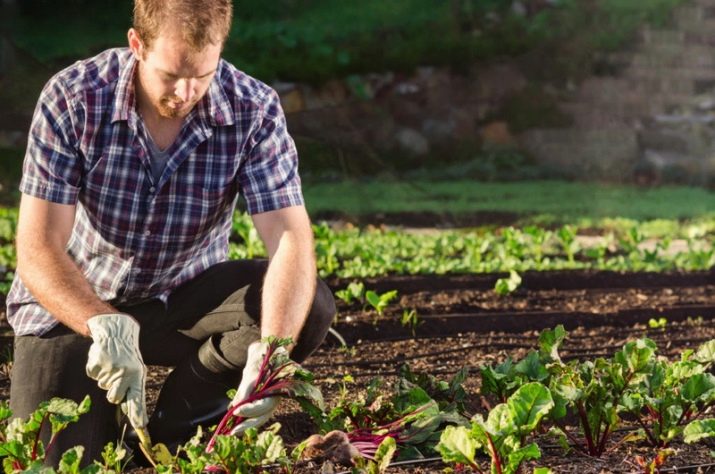After what crops can be planted?

Experienced gardeners know that it is unacceptable to plant the same plants in the same place of the land plot for a long period of time - the crops will gradually start to hurt, and the crop, in general, will not please. Therefore, it is worthwhile for newcomers of a land case to learn in advance what crops you can plant beets and other root crops, because these representatives of the flora are most susceptible to various types of growing conditions.
Special features
If the same type of vegetable or root crop is planted annually in a certain area of the vegetable garden, one can cause significant damage to the soil and, more precisely, to the productivity of the soil. Sometimes even a large amount of fertilizer can not fix the situation. Some vegetables belonging to a particular selected family can be planted in one area only for a maximum of four years. Therefore, it is necessary to think over the planting of root crops well, so that various parasites and unpleasant diseases do not start in one area of the garden.
Beetroot belongs to the category of unpretentious plants. It can grow on any type of soil. However, the advantage is to give the land with a low percentage of acidity, "fluffy", not knocked down. The culture loves frequent and good watering, especially on dry days.
To get a bountiful harvest of beets, you need to get acquainted with the rules of crop rotation and choose the right place for planting this root. Cold, constant shade, heavy clay soil with high acidity - all this is not the best options for the active growth of seeds. In such conditions it is worth being prepared for the minimum yield and its poor quality.
If the beets are located in the shade, the fruits will not get a good, rich color, because it appears only due to the sun's rays. The soil before planting must be loosened. At the same time, fertilizer is applied.
After the done manipulations, the open ground is ready for planting the root crop. But even if there is a spring outside the window, and according to the calendar you need to start sowing, you can plant beets only in the ground warmed to at least 5 degrees. If the planting is done in a cold ground, the fruits will not form, that is, there will be nothing to collect in the autumn.
When sowing, it is important to pay attention to the cultivar variety, because each type of root crop has its own characteristics: dense varieties will suit the round varieties, and the elongated ones like more loose earth.
The best option
Beets will give excellent harvest in the same place of the garden only the first 4 years. Then the fruits are shredded, they will become painful, the yield will decrease, and one fine day everything will go to the tops, the roots will not form at all. No one would like to spend a lot of time and effort on boarding and leaving, and in the end result get such a "gift." Therefore, even at the landing stage, it is better to decide right away, after which you can plant beets and what it likes to adjoin with, only this way the culture will feel good in the chosen territory.
To get a large and high-quality harvest of beets, it is better to sow it after plants that do not pull all the useful components out of the ground. Traditionally, the best predecessors are plants of the nightshade family. Since certain substances are necessary for their growth and they are all susceptible to the influence of identical pests, it is better to sow beets the next year after them.
The nightshade family is represented by several vegetables.
- Potatoes. Unpretentious, grows well in all climatic zones and environmental conditions. For high-quality shoots, a loose, pre-fertilized soil, a normal water regime and care, including preventive measures against the Colorado potato beetle, are necessary.
- Tomatoes. The soil before planting tomatoes need to fertilize, suitable peat and humus.
- Eggplant.
- Pepper.
After the harvest of solanaceous crops, it is necessary to free the territory from all kinds of vegetation residues.Thus, the land will rest until next year and will be ready to grow beets.
In addition to the solanaceae, planting root crops will be successful one year after picking cucumbers. The roots of the tops do not germinate deep into the ground, therefore, a sufficiently large amount of minerals necessary for the growth of beets will remain in the soil.
Growing root will have a beneficial effect on planting it after:
- cereals;
- legumes;
- squash;
- garlic;
- squash.
If you alternate the planting of these plants with a beet crop, you can improve the quality of the soil. Nutrients will be stored in the soil, which means that the root crop will be much larger and better in its main characteristics.
Good effect on the condition of the earth clover. During its growth, the soil rests and accumulates in its deeper layers a huge amount of useful trace elements. After collecting the grass, in its place in the spring, you can plant beets. Root will grow large, with beautiful color, strong and tasty.
Bad predecessors
Although beetroot grows well in the land in which various vegetables and herbs have grown before it, after collecting some plants, it is better not to plant this root crop. Sometimes the earth is so depleted that various infections develop in it, which adversely affect new shoots.
For cultures that pull all the “juices” out of the ground, include:
- spinach;
- carrot;
- rape;
- cabbage;
- chard.
All plants from the list have approximately the same requirements for growth conditions, they are also eaten by similar pests. That is why their annual landing negatively affects the land.
It is also not advisable to plant at the same place for several years in a row, although different, but still the same root beet varieties - beetroot. In the second year of cultivation, the crop is crushed, the roots will not be so beautiful, will become lethargic and lose the basic qualities. Moreover, such an alternation adversely affects the fertility of the soil, which will have to be restored for a long time.
Neighbors and helpers
In order for vegetables to produce the expected fruits, it is necessary to have an idea not only about how, after which it is better to plant them. It is also important to know the features and technology of growing all the surrounding neighbors. Beets will delight with an excellent harvest if the plants that grow near it do not pull out all the useful substances from the soil, that is, they do not hinder the normal development of their new neighbor in the garden.
Pumpkin (cucumber, zucchini, melon, pumpkin) garlic, onions, strawberries, lettuce, and spinach are considered ideal neighbors for beets. In addition to the neighbors with whom the beet has an excellent relationship, there are plant assistants. These include:
- chestnuts - do not allow the beet moth to overcome the root crop;
- coriander - deters rodents from the sweet root (even a small amount of spice is unpleasant to rats and mice);
- marigold - Medvedka is distilled from the root;
- marigold and chamomile medicinal - relieve planting beets from nematodes, slugs and butterflies.
Landing rules
Beets do not need to grow for many years in one place, even if the first year showed excellent results on the harvest. The following year, the fruits become shallow or completely absent, and after the time the plant simply degenerates. Goes to shoots and inflorescences.
The pause between plantings of this vegetable should be at least four years. That is, the first year at the selected place is growing beets, then you need to plant a different crop. And only four years later, you can return the root. It is advisable to add limestone fertilizer to the soil before planting beets.
You can highlight the main rules that can not be neglected when planting beets.
- Root crop is better to plant after crops with small roots.
- After the ill cultures, and those that have suffered the attack of pests, only healthy plants can be planted.
Summing up, you need to remember the main thing: the next year after the beets, it is better to plant legumes and nightshade.In no case can not be re-planted beets. If we neglect the basics of crop rotation, the land will exhaust its reserves of nutrients and forces, and even feeding with large amounts of fertilizers will not improve the situation, the yield of any crop will decline sharply.
On how to observe the crop rotation of vegetables in the garden, see the following video.




































